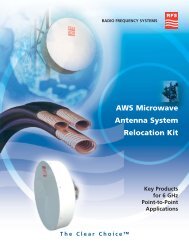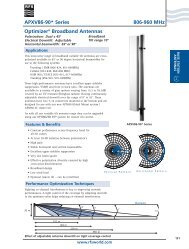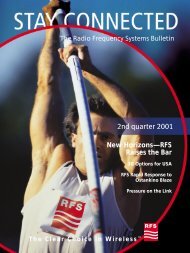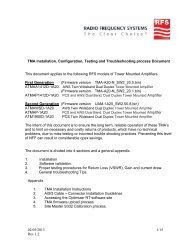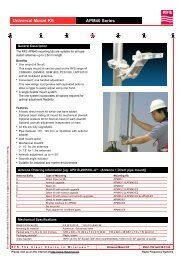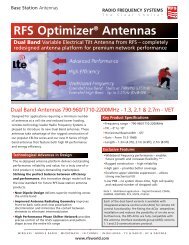download - Radio Frequency Systems
download - Radio Frequency Systems
download - Radio Frequency Systems
Create successful ePaper yourself
Turn your PDF publications into a flip-book with our unique Google optimized e-Paper software.
RFS: a world of<br />
microwave<br />
communications<br />
The equipment specified in the WSCA<br />
purchasing agreement represent a small<br />
part of the complete RFS microwave<br />
product suite. The full range of RFS<br />
microwave antennas is the most<br />
comprehensive in the industry, available in<br />
all common frequency bands up to 40 GHz.<br />
The microwave product range includes:<br />
Solid parabolic microwave antennas—<br />
point-to-point antennas in four performance<br />
classes—Standard, Improved,<br />
High and Ultra High—offering complete<br />
flexibility when designing a network.<br />
This range includes the popular RFS<br />
SlimLine and CompactLine series antennas.<br />
RFS SlimLine and CompactLine antennas—<br />
cost-effective microwave solutions for<br />
mobile operators and private microwave<br />
users. The SlimLine series antennas utilize<br />
a conventional feed system and are<br />
available in Standard, High and Ultra High<br />
performance versions. The CompactLine<br />
series antennas use a special feed system,<br />
which results in a reduced shroud length<br />
and consequently a lower antenna profile.<br />
This CompactLine range is extending with<br />
the release of the three-foot diameter<br />
SB3 series, the new two-foot diameter,<br />
10-GHz SB2-105 antenna (see What’s New<br />
pages), and the new four-foot diameter,<br />
7.1-GHz SB4-W71 antenna products.<br />
Microwave grid antennas—heavy-duty<br />
antennas in four basic types for<br />
low capacity rural telephony, Spread<br />
Spectrum/ISM band and wireless local loop<br />
(WLL) applications.<br />
Broadband wireless antennas—a wide<br />
variety of point to multipoint antennas for<br />
WLL, local multipoint distribution system<br />
(LMDS) and multipoint microwave<br />
distribution system (MMDS) applications.<br />
RFS FLEXWELL waveguides and accessories—in<br />
support of the microwave<br />
antenna, the corrugated elliptical waveguide<br />
provides the highest quality<br />
transmission medium for the radio-toantenna<br />
microwave link.<br />
US public safety radio<br />
contract awarded to RFS<br />
The signing of a new purchasing agreement for RFS microwave equipment<br />
provides a number of US states with a cost-effective means of improving<br />
public safety infrastructure.<br />
The Western States Contracting Alliance<br />
(WSCA) has finalized its contract for the<br />
purchase of public safety communications<br />
equipment. The development enables<br />
government agencies, sub-agencies and<br />
political non-profit organizations, within<br />
the WSCA member states, to purchase<br />
microwave antennas, waveguide, and<br />
related accessories directly from the<br />
competitively awarded contract. Wireless<br />
technology group <strong>Radio</strong> <strong>Frequency</strong> <strong>Systems</strong><br />
was the sole awardee for the two phases of<br />
the US$10 million contract, signed in<br />
November 2003, which pertain to existing<br />
and new microwave networks respectively.<br />
According to RFS District Sales Manager<br />
Tim Twiford, the purchasing agreement<br />
comes at a time of major investment in<br />
public safety radio networks in the US. The<br />
need for greater infrastructure to support<br />
more communities and roads is one factor<br />
behind this. The federal government’s drive<br />
for a reliable communications backbone<br />
across the country—especially in the wake<br />
of national security threats—is another.<br />
“They don’t want the equipment to fail.<br />
So, while every state has these networks in<br />
place already, many of them need to be<br />
upgraded to newer digital systems,”<br />
said Twiford.<br />
One of the key issues that the WSCA<br />
contract will, in part, address is the issue of<br />
interoperability. The public safety radio<br />
networks, be they for police, fire-fighting or<br />
transport, have traditionally used a variety<br />
of vendor systems, supporting different<br />
communications formats and frequencies<br />
from VHF 150 MHz to PCS 1900 MHz.<br />
By enabling the states to obtain highperformance<br />
microwave components<br />
directly from RFS, without the administrative<br />
burden of having to manage multiple<br />
MICROWAVE<br />
bids, the contract takes a step towards<br />
equipment standardization. Twiford believes<br />
that the impact will be<br />
increasing inter-working between public<br />
safety radio systems across the region, “By<br />
using equipment that is standardized,<br />
or that can work together and talk to<br />
each other, they will be able to handle<br />
emergencies that go across counties<br />
or jurisdictions.”<br />
15




